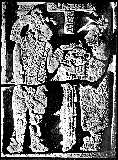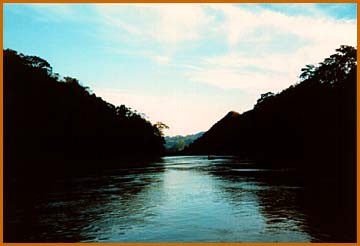 The Usumacinta River. Color photos by Susan Roberts. |
Guatemala, Department of Peten. Altar de Sacrificios. July, 1895 and June, 1904. On the 10th of July we continued our journey without stopping until we reached the cabins of Plancha de Piedra on the left bank of the river. Here lived two men, Navarro and Gama, for whom things had grown too hot in Mexico. |
| Although I was instantly aware that I was dealing with individuals of extremely doubtful character, I was nevertheless obliged to engage their services for large pay, since the lazy fellows I had brought from Sacluk refused to accompany me further. These two men were also well acquainted with the ruins of Altar de Sacrificos, which were in the immediate vicinity, and I therefore felt it expedient to appear unconscious of any irregularities in their lives. |
| The filth and degradation of the lonely hut, in which I was to spend the night, beggars description. I cleaned out one corner in which I was to sleep, But I could not avoid hearing and seeing many disagreeable things. In all my journeyings on the treacherous waters of the Usumatsintla, between El Cayo and Saiyaxche, I have been forcibly struck by the extraordinary contrast between the lavish beauty of nature and the extreme degradation of the remnants of humanity existing there. | 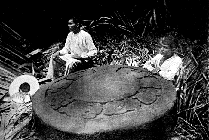
|

| Luxuriant vegetation of emerald hue bends in flower-laden branches to the water's edge, overarched by a sky of purest azure; brilliant-hued butterflies and humming birds with metallic sheen fly from flower to flower; gorgeous birds build their nests in every tree; even the snakes and iguanodons are graceful and beautiful... |
| It is long since a respectable, stationary population inhabited these fruitful shores, and the dubious elements sunk in sloth, filth, and every possible vice, whose miserable habitations are met with here and there, are constantly shifting since they acquire no fixed property rights. ... During my second visit to Altar de Sacrificios (1904) I narrowly escaped being drawn into a bloody affair which occurred very near us... I will give an account of the affray, in order to convey some idea of the lamentable disturbances which arise, even where the investment of capital and a superfluity of the necessities of life obviate the miseries of poverty. |

| The Mexican and Guatemalan governments give concessions to capitalists for cutting precious woods and for collecting chicle and caoutchouc, and the managers of these enterprises set up their monterias on the banks of the most navigable rivers. The workmen (monteros., chicleros., huleros.), most of whom are brought here from a distance, all receive high wages, free board, and many perquisites. Although every want is provided for and they have been paid many hundred pesos in advance, and have abundant food, such is the depravity of these people that they constantly invent pretexts for deserting their work in order to resume their vicious life in the villages. |
| This tendency to violate contracts perpetually occasions bloody conflicts between the managers and the men. An encargado. either shoots a recalcitrant mozo., or the mozos. kill the encargados.; and the men secretly procure brandy and attack each other with their machetes in drunken brawls! A few days before the affray alluded to, several mozos., very much in debt and tired of work, escaped from the settlement of Lagarto on the Lacantun River, belonging to Mr. Charles H______, an American. After paddling down the Lacantun they speedily went on shore on the Guatemalan side of the Usumatsintla, where they considered themselves safe. Here they abandoned the stolen cayuco., intending to work their way on foot through the forests along the banks of the river. |
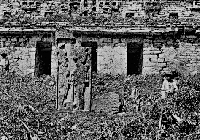
|
|
Romero and
his men crossed the strip of land between the Lacantun and the Cixoy on foot
and reached the monteria. in charge of his father, Guadaloupe Romero,
situated on the lower Chixoy. Here without delay they took a cayuco.,
intending to head off the fugitives by water.
Scarcely had they entered the Usumatsintla when a bloody encounter took place between the pursuers and pursued, for each party opened fire on the other. |
| One man was killed on each side, to the terror of the milder-mannered vogas. of Otero's cayuco., who flung themselves flat on the bottom of their boat and remained there until the battle was over. The men from the Lacuntun monteria. turned back in all haste, carring the body of their young encargado. with them, while the vogas. of Otero's cayuco carried their dead mozo. to Plancha de Piedra, where they also put ashore his companions. |
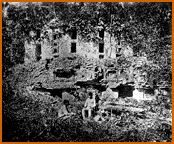
|
| Of course there is always a simulacro de justicia. enacted on each occasion. La exhortaciones judiciales. fly back and forth between the two countries, but this does not prevent the miscreants from taking a journey "around the world" in the meantime to seek the particular spot where they are not likely to be molested. That even an explorer of ruins is to a certain extent exposed to danger amid these idyllic surroundings is a matter of course, especially as he is supposed always to carry a sum of money about with him. |
| * Excerpted from Explorations of the Upper Usumatsintla and Adjacent Region: Altar de Sacrificios; Seibal; Itsimté-Sácluk; Cankuen. Memoirs 4(1). Peabody Museum of American Archaeology and Ethnology, Harvard University, Cambridge, MA. (Maler 1908:3, 8) |


